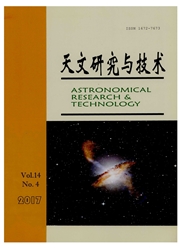

 中文摘要:
中文摘要:
现代日晕光度计是用于精确测定日间天文监测址点多种大气参量的精密仪器,它已列为我国西部太阳设备选址工作中的重要设备之一。在数据处理中日心坐标的选取对处理结果有决定性影响,但由于观测过程中日面中心坐标在图像上随时间变化,因此发展了两种用于日面中心自动定位的方法:日面总强度法和傅里叶变换相关法。详细介绍了这两种方法,并对比取得的结果差别及其对测量结果的影响。
 英文摘要:
英文摘要:
A modem Solar-Halo Photometer (SHP) is a precision instrument used to measure various atmospheric parameters for astronomical day-time observation sites. Such an instrument plays a key role in our solar-observation site survey program in the west China. The instrument takes the photometric measurements of muhiple wavelength bands. The accuracy of locating the solar-disk center can decisi'~ely affect the photometric results. The solar-disk center in an SHP image varies with time because of imperfect observation conditions. With fast increasing SHP data, there is a strong need to automatically reduce the data. Here we develop two automatic methods for locating the solar-disk center coordinates : the total solar-disk intensity curve method and the Fourier-coefficients correlation method. The first method searches for the maximum of the variation curve of the total solar-disk intensity, which is taken as the solar-disk center in the image. The second method searches for the most significant correlation b~;tween the Fourier coefficients of a mask of the solar-disk and the recorded image. We have compared the solar-disk coordinates obtained by these two methods and find that the results are very close, showing the two methods are consistent and either one can be used. With the two methods we will be able to reduce SHP data in future analyses.
 同期刊论文项目
同期刊论文项目
 同项目期刊论文
同项目期刊论文
 EXTREME-ULTRAVIOLET MULTI-WAVELENGTH OBSERVATIONS OF QUASI-PERIODIC PULSATIONS IN A SOLAR POST-FLARE
EXTREME-ULTRAVIOLET MULTI-WAVELENGTH OBSERVATIONS OF QUASI-PERIODIC PULSATIONS IN A SOLAR POST-FLARE EVIDENCE FOR THE WAVE NATURE OF AN EXTREME ULTRAVIOLET WAVE OBSERVED BY THE ATMOSPHERIC IMAGING ASSE
EVIDENCE FOR THE WAVE NATURE OF AN EXTREME ULTRAVIOLET WAVE OBSERVED BY THE ATMOSPHERIC IMAGING ASSE ON A CORONAL BLOWOUT JET: THE FIRST OBSERVATION OF A SIMULTANEOUSLY PRODUCED BUBBLE-LIKE CME AND A J
ON A CORONAL BLOWOUT JET: THE FIRST OBSERVATION OF A SIMULTANEOUSLY PRODUCED BUBBLE-LIKE CME AND A J Observation of High-speed Outflows in Coronal Loops Associated with Photospheric Magnetic Field Evol
Observation of High-speed Outflows in Coronal Loops Associated with Photospheric Magnetic Field Evol SIMULTANEOUS OBSERVATION OF SOLAR OSCILLATIONS ASSOCIATED WITH CORONAL LOOPS FROM THE PHOTOSPHERE TO
SIMULTANEOUS OBSERVATION OF SOLAR OSCILLATIONS ASSOCIATED WITH CORONAL LOOPS FROM THE PHOTOSPHERE TO Tracking the evolution of a coherent magnetic flux rope continuously from the inner to the outer cor
Tracking the evolution of a coherent magnetic flux rope continuously from the inner to the outer cor A statistical study of the post-impulsive-phase acceleration of flare-associated coronal mass ejecti
A statistical study of the post-impulsive-phase acceleration of flare-associated coronal mass ejecti Evolution of hard x-ray sources and ultraviolet solar flare ribbons for a confined eruption of a mag
Evolution of hard x-ray sources and ultraviolet solar flare ribbons for a confined eruption of a mag A study of the build-up, initiation, and acceleration of 2008 april 26 coronal mass ejection observe
A study of the build-up, initiation, and acceleration of 2008 april 26 coronal mass ejection observe Developing an Advanced Automated Method for Solar Filament Recognition and Its Scientific Applicatio
Developing an Advanced Automated Method for Solar Filament Recognition and Its Scientific Applicatio Differential emission measure analysis of multiple structural components of coronal mass ejections i
Differential emission measure analysis of multiple structural components of coronal mass ejections i Observations of a Quasi-periodic, Fast-Propagating Magnetosonic Wave in Multiple Wavelengths and Its
Observations of a Quasi-periodic, Fast-Propagating Magnetosonic Wave in Multiple Wavelengths and Its Diffraction, refraction, and reflection of an extreme-ultraviolet wave observed during its interacti
Diffraction, refraction, and reflection of an extreme-ultraviolet wave observed during its interacti Observational study of the quasi-periodic fast-propagating magnetosonic waves and the associated fla
Observational study of the quasi-periodic fast-propagating magnetosonic waves and the associated fla Simultaneous observations of a large-scale wave event in the solar atmosphere: from photosphere to c
Simultaneous observations of a large-scale wave event in the solar atmosphere: from photosphere to c MAGNETIC FIELDS OF AN ACTIVE REGION FILAMENT FROM FULL STOKES ANALYSIS OF Si I 1082.7 nm AND He I 10
MAGNETIC FIELDS OF AN ACTIVE REGION FILAMENT FROM FULL STOKES ANALYSIS OF Si I 1082.7 nm AND He I 10 Kinematics and fine structure of an unwinding polar jet observed by the solar dynamic observatory/at
Kinematics and fine structure of an unwinding polar jet observed by the solar dynamic observatory/at A time series of filament eruptions observed by three eyes from space: from failed to successful eru
A time series of filament eruptions observed by three eyes from space: from failed to successful eru 期刊信息
期刊信息
